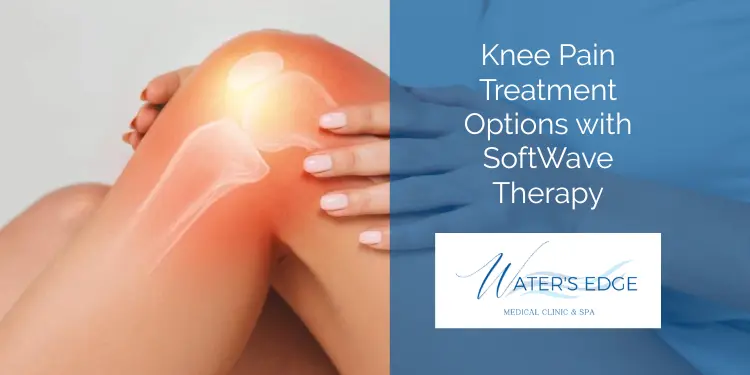Dealing with knee pain can really throw a wrench into your daily life. Whether it’s a dull ache or sharp, sudden pain, exploring the right knee pain treatment options is key. We’ll look at what’s out there, from common approaches to newer methods like SoftWave Therapy, to help you understand your choices for getting back on your feet.
Key Takeaways
- Using advanced sound wave technology, SoftWave Therapy offers a non-invasive solution to reduce knee pain and accelerate healing.
- It can help with various knee issues, including chronic pain, tendonitis, and meniscal tears, by stimulating the body’s natural repair processes.
- Compared to traditional methods, SoftWave Therapy offers a gentler approach with minimal side effects and can lead to improved mobility and lasting relief.
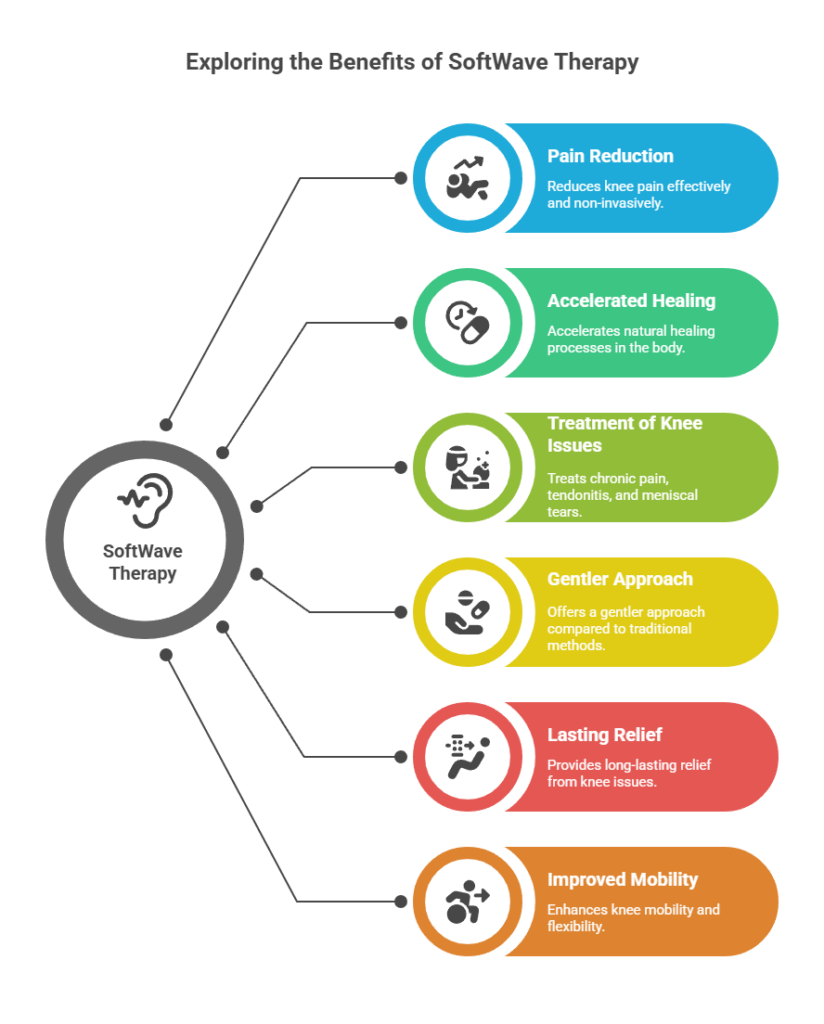
Understanding Your Knee Pain: The Foundation of Effective Knee Pain Treatment Options
Knee pain is a widespread problem that impacts many people, making everyday tasks difficult and lowering overall life quality. It’s not just a minor inconvenience; for some, it can be quite debilitating. The reasons behind knee pain are varied, ranging from sudden injuries to long-term health issues. Getting a clear picture of what’s causing your knee pain is the first, most important step toward finding the right treatment. Without understanding the root cause, it’s hard to know which options will actually help. We need to look at the different ways knee pain can start so we can figure out the best path forward.
Causes of Knee Pain
- Acute injuries: These happen suddenly, like tearing a ligament (think ACL tears), damaging the meniscus, or even breaking a bone. They’re usually the result of a specific accident or event.
- Overuse injuries: Conditions like tendinitis and bursitis are common examples in this category. They often develop because of repeated stress on the knee joint over time.
- Degenerative conditions: Osteoarthritis is the most common condition in this category, marked by the gradual breakdown of cartilage in the knee joint. This leads to pain and stiffness.
Traditional Treatments
- Medication: Doctors often suggest nonsteroidal anti-inflammatory drugs (NSAIDs) to help manage pain and swelling.
- Physical Therapy: By targeting the muscles around the knee, specific exercises improve stability and help the joint move more efficiently.
- Surgery: For more serious cases, procedures like arthroscopy or knee replacement might be recommended to fix or replace parts of the knee.
Many people find that these traditional methods don’t provide enough relief, pushing them to look for other solutions. This is where treatments like SoftWave Therapy come into play, offering a different approach to managing knee discomfort.
It’s important to remember that everyone’s knee pain is unique. What works for one person might not work for another, which is why a proper diagnosis is so important before starting any treatment plan.
For those seeking relief, exploring different avenues is key. Some patients have found success with shockwave therapy for knee pain.
Traditional Knee Pain Treatment Options: What Works and What Doesn’t
When knee pain strikes, it can really throw a wrench in your day-to-day life. Many people wonder what can be done for knee pain without surgery, and thankfully, there are several approaches to consider before jumping to more invasive options. These traditional methods aim to manage pain, reduce inflammation, and improve function.
Medications
Common over-the-counter options like ibuprofen or naproxen are often used to relieve mild to moderate knee discomfort, are commonly used as the first line of defense. These nonsteroidal anti-inflammatory drugs (NSAIDs) can help reduce pain and swelling. For more persistent pain, a doctor might prescribe stronger NSAIDs or other types of pain medication. It’s important to use these as directed, as they can have side effects.
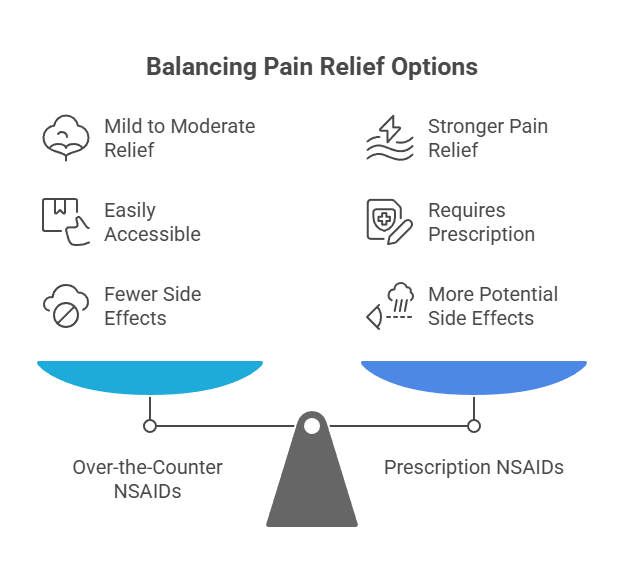
Physical Therapy
This is a big one for knee pain. Strengthening the muscles around your knee is key—and to ease knee pain quickly, corticosteroid injections help reduce inflammation directly in the jointA personalized plan from a physical therapist ensures exercises are safe, effective, and made just for you, like your quadriceps and hamstrings. Stronger muscles can help stabilize the joint and reduce the load on the knee itself. They might also use techniques like stretching, manual therapy, and modalities to help with pain and mobility. Think of it as building a better support system for your knee.
Injections
Sometimes, injections can provide targeted relief. To ease knee pain quickly, corticosteroid injections help reduce inflammation directly in the joint, offering temporary but significant relief. Another option is hyaluronic acid injections, which can help lubricate the joint, similar to the natural fluid found in healthy knees. These are often used when other treatments haven’t provided enough relief. Regenerative therapies such as PRP, and stem cells are also a great alternative with no significant side effects. These treatments are actually regenerative and in the long run slow down degeneration and actually help regenerate affective tissue.
Lifestyle Modifications
Simple changes can make a difference too. This might include losing weight if you are overweight, as extra pounds put more stress on your knees. Modifying activities that aggravate your pain, like switching from high-impact exercises to lower-impact ones such as swimming or cycling, can also be very helpful. It’s about finding ways to move that don’t worsen the problem.
Although many people find relief with traditional treatments, others may need advanced options, they don’t always provide a complete solution. Some individuals may find that these treatments offer only temporary relief or don’t address the underlying cause of their pain sufficiently. This is where exploring other options, like those offered at Waters Edge Medical Clinic and SPA, becomes important for those seeking more lasting results.
Activity Modification
Sometimes, the best approach is to simply adjust how you do things. This means identifying which movements or activities make your knee pain worse and finding ways to modify them or avoid them altogether. For instance, if climbing stairs is painful, you might explore using an elevator or taking the stairs one at a time, pausing on each step. This is a form of active pain management, focusing on how you engage with your daily tasks to minimize discomfort.
Unlike passive methods that require waiting for treatment, this approach involves continuous adjustment in your daily routine, which can be more efficient for managing ongoing knee discomfort. Active pain management is generally more effective than passive methods because it involves continuous treatment.
Introducing SoftWave Therapy: A Game-Changer in Knee Pain Treatment Options
SoftWave Therapy is making waves, pardon the pun, in how we approach knee pain. It’s a pretty neat option because it doesn’t involve cutting you open or prescribing a bunch of pills. Instead, it uses sound waves to get your body to heal itself. Think of it as a nudge for your natural repair systems.
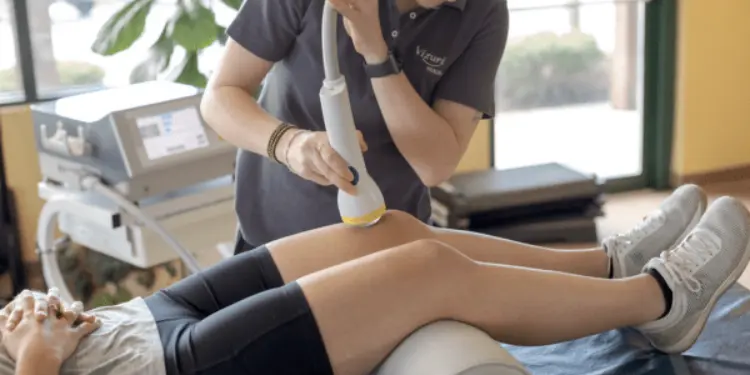
Many people find it offers significant pain relief, with some reporting a 50-90% reduction in pain within just a few sessions. It really helps calm down inflammation and loosen up tight muscles, which can make a huge difference in how your knee feels and moves. It’s a real step forward for managing pain without surgery or long-term medication.
Mechanism of Action: How SoftWave Works
So, how does this actually work? SoftWave Therapy uses special devices to create high-energy sound waves. These waves are directed at your knee from outside your body. They go through the skin and tissues to reach the problem areas.
- Shock Waves: These are powerful sound waves, not electrical ones. They’re aimed at the knee to get things moving.
- Stimulating Healing: The energy from these waves actually causes tiny, controlled micro-injuries. This sounds bad, but it’s good! It tells your body, “Hey, something needs fixing here!” This boosts blood flow, cuts down on swelling, and encourages damaged tissue to repair itself.
- Reducing Pain: By kicking off your body’s own healing processes and sometimes breaking down hardened tissue or scar tissue, SoftWave can really cut down on knee pain. It also seems to block pain signals, giving you some relief pretty quickly.
Benefits of SoftWave Therapy for Knee Pain
This therapy has a lot going for it, especially when you compare it to other options. It’s a big deal because it tackles knee pain without surgery.
- Non-Invasive Treatment: This is a major plus. No cuts, no anesthesia, and no lengthy recovery time. You can usually get back to your day right after a session.
- Pain Management and Reduction: Patients often feel a noticeable drop in knee pain after just a few treatments. It helps reduce swelling and gets your body’s natural healing going, which really improves daily life.
- Enhanced Mobility and Functionality: When the pain eases and tissues start to repair, your knee can move better. This means easier daily activities, more comfortable exercise, and better results from physical therapy.
- Safe with Minimal Side Effects: This approach stands out as a low-risk option when compared to surgery or extended medication use, SoftWave is quite safe. Most people don’t have any bad reactions, making it a lower-risk choice.
- Versatility: It’s been used for all sorts of knee issues, like arthritis, tendon problems, ligament injuries, and even pain after surgery. It’s a flexible tool for doctors and therapists.
How SoftWave Differs from Traditional Shockwave Therapy for Knees
It’s important to know that not all shockwave therapies are the same. Traditional devices often focus their energy on a small spot near the surface. SoftWave, however, uses a broader, deeper-reaching wave. This wider reach helps recruit more stem cells and encourages healing over a larger area. The energy is less focused, meaning it can heal without causing the kind of micro-damage that some older methods might. This makes SoftWave TRT a gentler, yet more effective, way to get your body to regenerate tissue.
Patient Eligibility for SoftWave Therapy
Deciding if SoftWave Therapy is right for you is an important first step. It’s a modern therapy that offers a lot of promise for people dealing with knee pain. Checking out patient video testimonials for SoftWave Therapy can give you a good idea of what others have experienced.
Comparing SoftWave with Other Knee Pain Treatment Options
When looking at different ways to handle knee pain, it’s helpful to see how SoftWave Therapy stacks up against more common approaches. Many people have tried various treatments, and Recognizing the differences between treatments helps you find the best path to lasting relief.
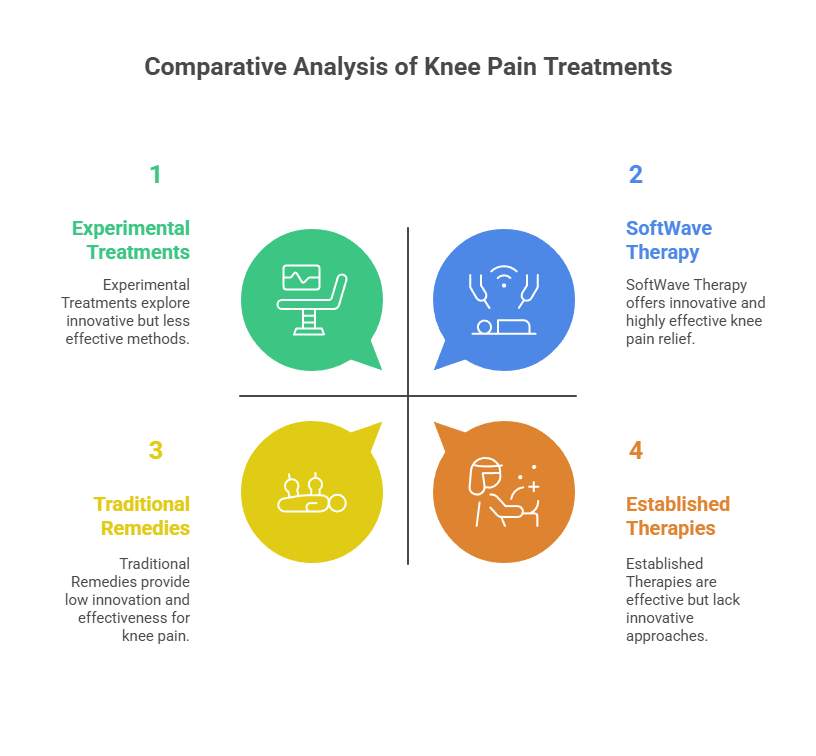
Medications
Medications, particularly NSAIDs, are often the first line of defense for knee pain. They can help reduce swelling and discomfort. However, they primarily manage symptoms rather than addressing the root cause of the pain. Long-term use can also come with side effects, which is something to consider.
Physical Therapy
For knee pain relief, physical therapy is typically the initial and most crucial part of the treatment plan. It works by building muscle around the knee, enhancing flexibility, and improving joint performance. While highly effective for many, progress can sometimes be slow, and consistent effort is required. It’s a great option for improving stability and mobility.
Surgery
For severe knee issues, surgery like arthroscopy or knee replacement might be recommended. These procedures can offer significant relief but involve downtime, potential risks, and a lengthy recovery period. These treatments are usually reserved for cases where conservative methods haven’t delivered sufficient relief.
SoftWave Therapy vs. Other Options
SoftWave Therapy offers a different path. It’s a non-invasive treatment that aims to stimulate the body’s natural healing processes. Unlike medications that mask pain or surgery that requires intervention, SoftWave Therapy works by promoting cellular repair. This approach can lead to lasting pain reduction and improved function. It’s a treatment that targets the underlying issues contributing to knee pain. Many patients find it provides relief without the side effects or recovery time associated with other methods. For those seeking to address knee pain, exploring SoftWave Therapy for knee pain can be a beneficial step.
SoftWave Therapy and Electrical Nerve Stimulation (ENS)
It’s also worth noting how SoftWave Therapy differs from treatments like Electrical Nerve Stimulation (ENS). While ENS can offer temporary pain relief by blocking nerve signals, SoftWave Therapy focuses on healing and regeneration. SoftWave offers a long-term approach by addressing what’s causing the pain instead of just covering it up. The key distinction lies in their approach: SoftWave targets the root cause of pain through cellular regeneration, whereas ENS provides a more immediate but less enduring solution by interrupting nerve signals. This makes SoftWave Therapy and ENS quite different in their outcomes.
Benefits Summary
Here’s a quick look at how SoftWave Therapy compares:
- Non-Invasive: No cuts, no anesthesia, and no downtime. You can usually go back to your daily activities right away.
- Pain Reduction: Many patients report a noticeable decrease in knee pain after sessions.
- Improved Function: It helps restore mobility and makes it easier to move and exercise.
- Safety: It has a good safety record with minimal reported side effects.
- Versatility: It can help with various knee problems, including arthritis, tendonitis, and injuries.
SoftWave Therapy stands out as a promising option for knee pain because it works with the body’s natural healing abilities. It’s a way to get relief without the risks or recovery time of more involved treatments.
Choosing the Right Knee Pain Treatment Options for Long-Term Relief
When you’re dealing with knee pain, figuring out the best way to get relief can feel overwhelming. There are so many different approaches out there, and what works for one person might not be the best fit for another. It’s really about finding the right path for your specific situation to get that long-term improvement you’re looking for. Think about what your goals are – are you trying to get back to sports, or just manage daily discomfort? Your answers will help guide you.
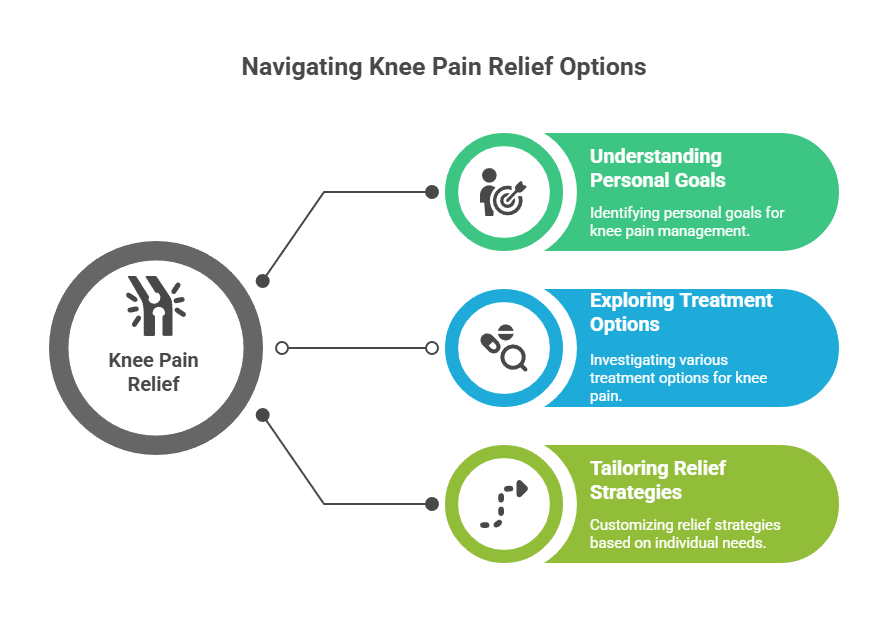
Evaluating Your Knee Pain and Treatment Goals
Effective knee pain relief begins with uncovering its root cause before selecting a treatment path. Is it from a sudden injury, or has it developed over time due to wear and tear? Knowing this helps narrow down the most effective options. For instance, if you’re dealing with chronic issues like osteoarthritis, you might explore different avenues than someone with an acute ligament tear. Understanding the ‘why’ behind your pain is the first step to finding the right ‘how’ for treatment.
Exploring Non-Surgical Knee Pain Treatment Options
Many people prefer to avoid surgery if possible, and thankfully, there are several effective non-surgical knee pain treatment options available. These can range from physical therapy and targeted exercises to medications for pain and inflammation. For those seeking advanced non-surgical knee pain treatment near me, therapies like SoftWave therapy are becoming increasingly popular. This approach uses sound waves to encourage the body’s natural healing processes, offering a way to address pain without incisions.
Considering SoftWave Therapy for Lasting Relief
SoftWave Therapy is a treatment that uses acoustic waves to stimulate tissue repair. It’s a non-invasive option that many find beneficial for various knee conditions, including patellar tendonitis. If you’ve tried other methods without success, or if you’re looking for a way to manage knee pain without surgery, this could be a good option to discuss with your doctor. It’s designed to help your body heal itself, potentially leading to longer-lasting results.
Making an Informed Decision
When deciding on the best course of action, consider these points:
- Consult with a healthcare professional: The right treatment starts with the right diagnosis—trust a professional to pinpoint the cause of your knee pain.
- Research different treatment modalities: Understand how each option works and what outcomes to expect.
- Discuss your personal health history: Factors like your age, activity level, and overall health play a role in treatment effectiveness.
- Consider the recovery time: Some treatments require more downtime than others.
Ultimately, the most effective knee pain treatment options are those that are tailored to your individual needs and provide sustainable relief. Don’t hesitate to ask questions and explore every option to find the best solution for your knee health.
Wrapping Up Your Knee Pain Journey
So, we’ve talked a lot about knee pain and how SoftWave Therapy might help. It seems like a pretty interesting option, especially if you’re not keen on surgery or long recovery times. It works by using sound waves to get your body to heal itself, which is pretty neat.
Many people report less pain and better movement after trying it. Of course, everyone’s different, and what works for one person might not work for another. It’s always a good idea to chat with your doctor or a specialist to see if SoftWave is the right fit for your specific knee issues. They can help you figure out the best path forward for getting you back on your feet and feeling better.
Frequently Asked Questions

How does SoftWave Therapy help with knee pain?
SoftWave Therapy uses special sound waves to help your knee heal itself. These waves go deep into the knee and encourage your body to create more stem cells, which are like repair workers. This helps reduce swelling, repair damaged parts, and lessen pain. It’s a way to help your knee get better without surgery.
How long do the results of SoftWave Therapy for knees typically last?
The relief from SoftWave Therapy can last for a long time for many people, sometimes months or even years. However, everyone’s body is different. Some people might need extra sessions later on if their knee pain comes back or gets worse over time. It really depends on your specific situation and how your knee responds.
What is the average cost of SoftWave Therapy for knee pain?
The cost can differ based on where you live, the clinic you go to, and your personal treatment plan. Generally, it’s often less expensive than surgery. To get an exact price, you’ll need to ask the clinic or doctor providing the therapy directly. It’s good to think about the cost compared to how much better you might feel and how much more you can do.
If you have any additional questions or if you would lie to try Softwave therapy, Please contact us at Waters Edge Medical Clinic and receive a free consultation plus Softwave treatment for an introductory price of $49. 727-550-0855.

